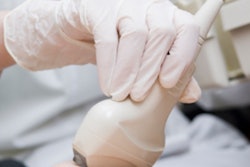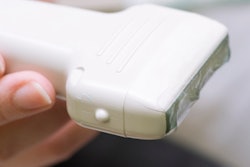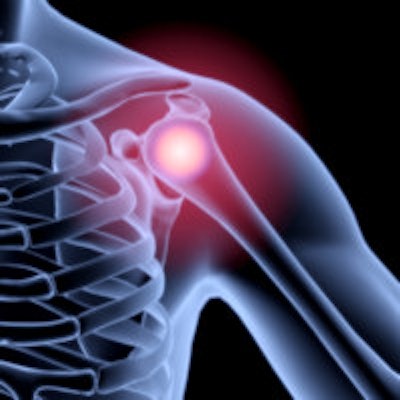
Patients presenting to the emergency department (ED) with acute shoulder pain typically receive an x-ray exam. However, ultrasound can provide equivalent performance -- often in less time and without the ionizing radiation -- for diagnosing shoulder dislocation, according to researchers from the University of California, Irvine.
In a study that examined 84 shoulders, ultrasound had 100% sensitivity and 100% specificity for diagnosing acute shoulder dislocations, compared with x-ray.
"We believe that [ultrasound] is an effective alternative to x-ray in the diagnosis of shoulder dislocations," said Alex Trinh, a fourth-year undergraduate medical student at the university. He presented the findings during a session at the recent American Institute of Ultrasound in Medicine (AIUM) annual meeting in Orlando, FL.
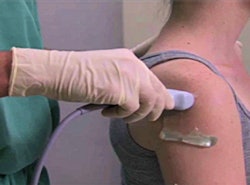 A posterior approach was used in the study. All images courtesy of Alex Trinh.
A posterior approach was used in the study. All images courtesy of Alex Trinh.Acute shoulder dislocations are commonly seen in the ED and affect 1.7% of the population in the U.S. Of the dislocations, 97% are anterior in nature, meaning that the humeral head is dislodged anteriorly to the glenoid rim, Trinh said.
The researchers set out to determine the sensitivity, specificity, and accuracy of ultrasound in diagnosing acute shoulder dislocation as performed by undergraduate research students. The secondary objective of the study was to develop standardized, reproducible criteria to confirm shoulder dislocation using point-of-care ultrasound.
The research project featured a prospective, convenience sample of patients presenting with acute shoulder pain. After the patient received an x-ray ordered by the attending physician, the research associate sought permission to perform a posterior, transverse ultrasound of the affected shoulder.
After an ultrasound image of the humeral head and glenoid rim was obtained, the glenohumeral separation distance was determined. If ultrasound shows that humeral head placement is posterior to the glenoid rim, then there is no dislocation, according to Trinh.
Conversely, "if the humeral head placement is anterior to the glenoid rim, the shoulder is likely anteriorly dislocated," he said.
Trinh and colleagues then cross-referenced the ultrasound results with the x-ray findings.
The 84 shoulders evaluated in the study included 19 anterior dislocations and 65 normal shoulders. Ultrasound diagnosed all 19 anterior dislocations and 65 normal shoulders, yielding 100% sensitivity, specificity, positive predictive value, and negative predictive value.
"Bedside ultrasound is an effective technique used to diagnose anterior dislocations," Trinh said.
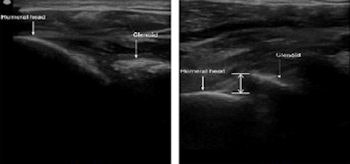
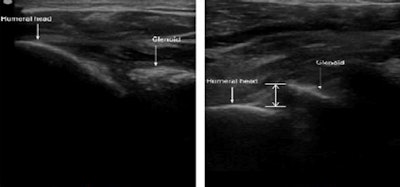
Ultrasound scans of normal (left) and anteriorly dislocated shoulder (right). The humeral head is located posterior to the glenoid rim in the normal shoulder. In the anterior dislocation, the humeral head is anterior to the glenoid rim.
Benefits
Point-of-care ultrasound offers many benefits, including the ability to expedite the care of the shoulder, Trinh explained.
"Oftentimes x-rays may take up to 40 or 45 minutes, depending on the saturation of the emergency department," he said.
The use of ultrasound also results in less exposure to ionizing radiation for patients, and it's time-efficient and noninvasive. Furthermore, undergraduate research students were able to perform the exam successfully, obtaining adequate images with minimal training.
However, "the lack of clinical training effectively blinds the student from making a clinical diagnosis of the shoulder dislocation," Trinh said.
He acknowledged several limitations of the study, including its small sample size and reliance on a convenience sample at a single site. The project also did not explore the possibility of inferior/posterior dislocations, which can't be diagnosed on ultrasound because the humeral head would be posterior to the glenoid.
"There's also the possibility of fractures, which our research personnel won't be able to accurately diagnose," he added.
Future studies will analyze the level of risk patients would be willing to accept to forego an x-ray, taking into account lower costs and decreased exposure to radiation, he said. In addition, the group will analyze the difficulty of dislocation reduction with a qualitative value of the glenohumeral step-off distance.





